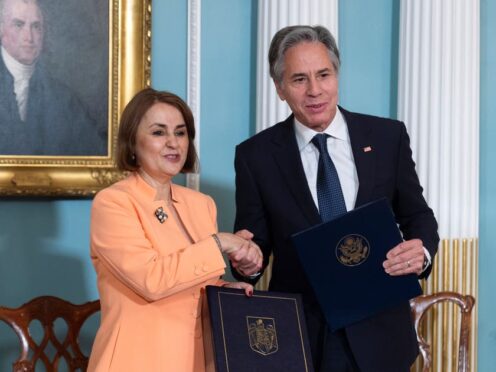
The Biden administration on Friday thanked Romania for its president withdrawing from the race to lead Nato, saying the move would help ensure the Western military alliance stays properly focused.
Secretary of State Antony Blinken delivered the message to his Romanian counterpart Luminița-Teodora Odobescu. Their meeting on Friday at the State Department came just a day after Romanian President Klaus Iohannis dropped out of the running for Nato’s top job, clearing the way for outgoing Dutch Prime Minister Mark Rutte.
Mr Blinken said he was “grateful” for Mr Iohannis’s leadership in the alliance, although he did not specifically mention the contest to be Nato’s next secretary-general.
“Romania has played a critical role in making sure that the alliance is focused everywhere it needs to be focused, including on our eastern flank,” Mr Blinken said. “We’re grateful for that. I am grateful for President Iohannis and his leadership and making sure the alliance is appropriately focused.”

Two US officials said Washington was pleased by Mr Iohannis’s decision to withdraw, suggesting it was a sign that Romania takes its alliance responsibilities seriously. Those officials spoke on condition of anonymity to discuss internal Biden administration thinking.
Mr Iohannis is nearing the end of his second five-year term as Romania’s president and had announced his intention to run for Nato’s top job in March.
Romania, a Nato member since 2004, borders Ukraine and has played an increasingly prominent role in the alliance throughout Russia’s full-scale invasion, including hosting a Nato meeting of foreign ministers in November 2022.
Mr Iohannis’s withdrawal means that Mr Rutte is all but certain to replace Jens Stoltenberg at the top of the alliance when its leaders meet next month in Washington to celebrate Nato’s 75th anniversary.
It removed the last real hurdle Mr Rutte might have faced and should allow Nato to put on a show of unity and demonstrate solidarity with war-ravaged Ukraine when US President Joe Biden and his counterparts meet in Washington on July 9-11 for the summit.
Mr Rutte’s appointment could be sealed by a meeting of Nato ambassadors in the coming days or by the leaders when they meet in Washington. He would officially start work on October 1.
Nato secretaries-general are responsible for chairing meetings and guiding sometimes delicate consultations among the 32 member countries to ensure that an organisation that operates on consensus can continue to function.
Nato makes all its decisions by consensus, giving any of the member countries an effective veto, including on whether they should take part in any joint effort or operation.
Mr Rutte has for months been the preferred candidate of the majority of Nato allies, including big members like the US and Germany.

Enjoy the convenience of having The Sunday Post delivered as a digital ePaper straight to your smartphone, tablet or computer.
Subscribe for only £5.49 a month and enjoy all the benefits of the printed paper as a digital replica.
Subscribe